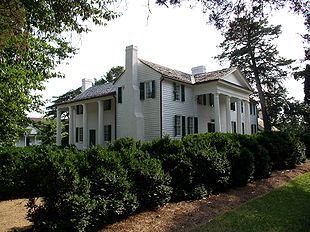
Clemson University Historic District II
Encyclopedia
The Clemson University Historic District II is a collection of historic properties on the campus of Clemson University
in Clemson, South Carolina
. The district contains 7 contributing properties located in the central portion of the campus. It was listed on the National Register of Historic Places
in 1990.
Clemson University
Clemson University is an American public, coeducational, land-grant, sea-grant, research university located in Clemson, South Carolina, United States....
in Clemson, South Carolina
Clemson, South Carolina
Clemson is a college town located in Pickens County in the U.S. state of South Carolina. The population was 11,939 at the 2000 census and center of an urban cluster with a total population of 42,199...
. The district contains 7 contributing properties located in the central portion of the campus. It was listed on the National Register of Historic Places
National Register of Historic Places
The National Register of Historic Places is the United States government's official list of districts, sites, buildings, structures, and objects deemed worthy of preservation...
in 1990.
Contributing properties
| Building | Photo | Built | Location | Notes |
|---|---|---|---|---|
| 34°40′39.5"N 82°50′20.3"W | John C. Calhoun's office on the premises of his Fort Hill estate served as his private library. Its Greek Revival Greek Revival architecture The Greek Revival was an architectural movement of the late 18th and early 19th centuries, predominantly in Northern Europe and the United States. A product of Hellenism, it may be looked upon as the last phase in the development of Neoclassical architecture... style echoes that of the main house. |
|||
| Fort Hill |  |
34°40′40.6"N 82°50′20.2"W | John C. Calhoun John C. Calhoun John Caldwell Calhoun was a leading politician and political theorist from South Carolina during the first half of the 19th century. Calhoun eloquently spoke out on every issue of his day, but often changed positions. Calhoun began his political career as a nationalist, modernizer, and proponent... purchased the plantation & house in 1825. It was passed to his daughter, Anna, and son-in-law Thomas Green Clemson Thomas Green Clemson Thomas Green Clemson, was an American politician and statesman, serving as an ambassador and the United States Superintendent of Agriculture. He served in the Confederate States Army... . Clemson willed the land to the State to be used for a public university. It was individually listed as a National Historic Landmark National Historic Landmark A National Historic Landmark is a building, site, structure, object, or district, that is officially recognized by the United States government for its historical significance... in 1960. |
|
| Hardin Hall | 1890 | 34°40′41.8"N 82°50′12.9"W | Hardin Hall is the oldest academic building on campus. It was originally built as the Chemistry laboratory, it was expanded in 1900 and 1937, and has housed the Education department and administration offices. It currently houses the departments of History, Philosophy, and Religion. | |
| Outdoor Theater | 1940 | 34°40′41.7"N 82°50′10.0"W | The Outdoor Theater was built as a gift of the Class of 1915, and designed by one of its members and the university's first architecture graduate, Leon LeGrand. The Art Deco Art Deco Art deco , or deco, is an eclectic artistic and design style that began in Paris in the 1920s and flourished internationally throughout the 1930s, into the World War II era. The style influenced all areas of design, including architecture and interior design, industrial design, fashion and... stage was nearly demolished and replaced in 1977, but protests prompted its renovation and the addition of concrete terraced seating. |
|
| Riggs Hall | 1927 | 34°40′37.2"N 82°50′16.4"W | Riggs Hall was built to replace Mechanical Hall, which burned in 1926. It was designed by Architecture department chairman Rudolph E. Lee. The departments of Architecture, Civil Engineering, Electrical Engineering, and Mechanical Engineering were the first tenants. Architecture and Civil Engineering moved into the new Structural Science Building in 1958, but Electrical and Mechanical Engineering are still located in the building. | |
| Sirrine Hall | 1938 | 34°40′37.4"N 82°50′21.5"W | Sirrine Hall was built to replace Godfrey Hall as the Textile building. It was one of 8 buildings built between 1936 and 1938, and designed by Rudolph E. Lee in an Italian Renaissance Revival Italianate architecture The Italianate style of architecture was a distinct 19th-century phase in the history of Classical architecture. In the Italianate style, the models and architectural vocabulary of 16th-century Italian Renaissance architecture, which had served as inspiration for both Palladianism and... style. Today, the building houses the College of Business. |
|
| Trustee House | 1904 | 34°40′42.3"N 82°50′17.1"W | The Trustee House was originally the home of Chemistry department chairman Mark B. Hardin. After his death, the Board of Trustees used it for meetings, and visiting dignitaries stayed in the house. |

